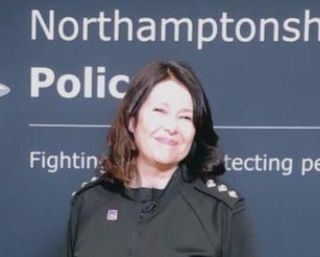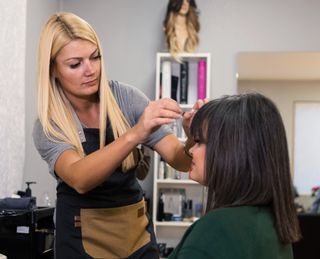How hairdressers became an unlikely haven in the nation’s domestic abuse crisis
Nearly one in three women have experienced violence at the hands of an intimate partner


As the world has grappled to contain the coronavirus over the past year and a half, another pandemic has taken hold.
This plague carries many of the same markers as COVID-19, transmitting most quickly indoors and infecting all household occupants.
It too introduces itself casually—in bars and restaurants—before trapping its victims inside their homes, forcing them to self-isolate and detach from loved ones. It targets the most vulnerable of society, leaving them desperately unwell and, in some cases, permanently damaged or even dead.
Unlike coronavirus, however, it cannot be eradicated with a vaccine.
Domestic abuse has drastically spiked since governments across the world implemented national lockdowns, mandating people to stay at home and scale back their contacts. Social distancing in public has translated to close proximity in private, with many families and couples’ net time together skyrocketing overnight to several consecutive hours a day. These longer stretches in the house haven’t been easy for anyone—but for some, they have been catastrophic.
As household conflicts heated up and escape routes froze over, the safety of domestic abuse victims worldwide became more imperative than ever. Months of cabin fever—often combined with financial stress and increased childcare duties—has only escalated tensions in abusive relationships, giving perpetrators more opportunities and more ‘excuses’ to attack. A site that had already been a danger zone for victims has become a hotspot for abuse—a haven from one virus, and a breeding ground for another.

Domestic abuse has drastically risen in the COVID-19 pandemic
In light of the disturbing statistic that nearly 1 in 3 women have experienced violence at the hands of an intimate partner, the UN launched its Shadow Pandemic campaign in May 2020 to raise awareness of the increase in global domestic abuse during lockdown.
Sign up for the woman&home newsletter
Sign up to our free daily email for the latest royal and entertainment news, interesting opinion, expert advice on styling and beauty trends, and no-nonsense guides to the health and wellness questions you want answered.
It had warned that compulsory confinement and social isolation would place victims in the firing lines of their perpetrators, making it more difficult for them to seek help or leave. Unfortunately, it would be correct in its predictions.
UK domestic abuse helpline Refuge has seen more than a 60% increase in calls since April 2020, while a BBC Panorama investigation found that two-thirds of women in abusive relationships had experienced an increase in violence during the pandemic. This rise in UK household abuse over the past sixteen months is reflected in the international community, with domestic violence reports and emergency calls jumping in countries—both developed and developing—across the globe.
In spite of these horrifying statistics, hope is not lost. The prevalence of this issue has reinforced the need for a community-led approach, in which nobody is exempt from playing their part. Ground-breaking campaigns like Cut it Out are spearheading this movement, moving the subject of domestic abuse out of the shadows and onto the high street.
Founded by the Northamptonshire Police in 2019, the initiative provides training to hair and beauty professionals on how to detect the warning signs of abuse in clients and how to safely refer them to the appropriate support services. By equipping customer-facing workers with these skills, Cut it Out aims to reach a much wider pool of people—offering critical support to those who mightn’t otherwise find it. With its expert-led training, it seeks to create a society with a zero-tolerance policy on domestic abuse.
To truly understand its mission, however, it’s important to revisit the tragic case of the woman who inspired its origins—Kerri McAuley.
How the case of Kerri McAuley inspired the Cut it Out campaign
In January 2017, a woman named Kerri McAuley was murdered by her ex-boyfriend. The Northern Irish mother-of-two had been trapped in an abusive relationship with Joe Storey for fifteen months, during which time she suffered an endless crusade of coercive control and physical attacks.
After one particularly brutal assault landed her in hospital, she decided to confide in her hairdresser, Annie Reilly, about the abuse. Her face bruised and swollen from the incident, she opened up about the disturbing details of the relationship—divulging information she had kept hidden throughout her custom at the Norwich salon.

The murder of Kerri McAuley inspired the launch of Cut it Out
Kerri revealed she was now being stalked by her perpetrator and harassed through emails, despite blocking him on all other social media platforms. Annie, stunned by her client’s condition, consoled her and advised her to “spam” and “ignore” the messages. Kerri then said, “I know he’s going to kill me,” a premonition that Annie, regrettably, interpreted as a figure of speech.
Kerri then said, “I know he’s going to kill me,” a premonition that Annie, regrettably, interpreted as a figure of speech.
Tragically, just two weeks later, Kerri was found dead by police in her Southalls Way flat. Storey was arrested at a nearby residence and sentenced to serve a minimum of 24 years in prison for murder.
This horrific case led to an outpouring of grief in the Norwich community, with many locals shocked by the sudden loss of life at the hands of such cruelty.
Between the devastation and confusion, however, lay a much more complex emotion: guilt—a prickly feeling that something that could have been done simply wasn’t. Kerri’s decision to confide in her hairdresser reinforces just how crucial the role of the community is in tackling domestic abuse, reminding us that businesses can be a valuable first point of contact when raising the alarm.
If society truly wants to combat this issue, it must relinquish the mindset that it is solely a police matter—an attitude that has proven, time and time again, to endanger victims and bolster perpetrators.
Why are hairdressers effective frontline workers against domestic abuse?
Cut it Out’s mission is to empower communities to tackle domestic abuse head-on—both literally and figuratively. The campaign aims to expand access to support services by placing aid stations at sites victims might least expect, like hairdressers, barbers, and beauty salons. These particular industries were selected because of their familiar environment—a safe backdrop that could help foster the trust needed to open up about this sensitive issue.
“So many women go back to their hairdressers, guys go to the same barbers, and you talk to these people because it’s a really intimate service,” says Chief Inspector Julie Mead, one of Cut it Out’s leading organizers.

Chief Inspector Julie Mead
Rather than ringing a helpline or calling the police—two actions that can be incredibly daunting for someone in an abusive relationship—victims can raise the issue with a familiar face, without the fear of their world suddenly falling apart.
“When you think about someone who might be in a coercive or controlling or violent relationship, it might be the only place they’re allowed to go”
Chief Inspector Julie Mead
“If you have a hairdresser, you have a consistent amount of time together. Because you’re so tactile with them, they feel so comfortable because you’re there to make them feel good and attractive,” explains Stacey Fotheringham, a hairdresser and Cut it Out training facilitator. “I think it’s just a natural profession that people start to confide in you about every aspect of their life.”
Salons and barbers are also, importantly, unlikely to raise suspicion from an abuser—who may be controlling their partner’s movements. “When you think about someone who might be in a coercive or controlling or violent relationship, it might be the only place they’re allowed to go,” says Julie.
How hairdressers are trained to spot violent or controlling relationships
Cut it Out’s training revolves around a simple core message: ask with kindness and listen without judgment. By equipping its participants with the tools to spot warning signs of domestic abuse, the course hopes to empower people to take that potentially life-saving first step to supporting a victim.
“Just being that listening ear to someone can be enough to help,” Police Community Support Officer and Cut it Out co-founder, Nadia Norman, explains. “You might be the first person that’s actually stopped and asked them if they’re okay.”
Because the warning signs of domestic abuse vary widely, Cut it Out introduces its participants to all its different faces. As well as covering the red flags of physical violence—such as bruises, black eyes, and sprained wrists—the training also explores the hidden symptoms of domestic abuse.
One key module is psychological abuse, which, by its nature, is a lot harder for outsiders to detect. It is also less likely to ring alarm bells for victims, who may not even register the perpetrator’s behavior as unhealthy.
“It’s really difficult for victims to come forward because they might even realize they’re a victim,” says Nadia. “We still have this stigma that domestic abuse has to be physical.”

Police Community Support Officer Nadia Norman
A common psychological abuse tactic is coercive control, which is characterized by a pattern of controlling the victim’s life over a prolonged period of time. It can manifest in a number of ways, including socially isolating the individual, monitoring their daily activities, and restricting their financial freedom. Victims are kept captive in psychological solitary confinement, cut off from their friends and family and left entirely dependent on their abuser for survival.
“We still have this stigma that domestic abuse has to be physical”
Officer Nadia Norman
Nadia hopes that, by recognizing these invisible signs, Cut it Out’s participants can give their clients the key to unlock the padlock.
“We ask people to look out for changes in behavior and to take those little flags that come into conversation—subtle things rather than the bruises or the black eye,” she says.
The training also covers the cycle of abuse, which is crucial to understanding the victim’s mindset. Perpetrators will often trap victims onto a dizzying Merry-Go-Round that can blur their perception of reality and/or wear them down to the point of despair. This vicious cycle is identified by the following four stages—the building of tension, the abusive incident, the reconciliation, and the calm aftermath.

Victims often become trapped into a vicious cycle of abuse
“You go from being very content, life is normal and then there’s always a trigger that brings it back around to an incident,” Nadia explains.
This relentless emotional rollercoaster reduces victims to a state of emotional and physical exhaustion, further weakening their ability to leave the relationship.
By understanding the complexity of this cycle, participants can gain a better appreciation of the victim’s perspective and withhold judgment of their decision to stay with the abuser.
While the training teaches a broad set of practical skills, it is not a crash course on becoming a domestic abuse expert overnight. Instead, it encourages the individual to view themselves as a first responder in the victim’s crisis—a trusting face who can signpost them to professional support services. Participants are not expected to graduate with PhD-quality knowledge, but rather with a certificate of First Aid techniques that could potentially prevent a fatal outcome.
“We were quite conscious at the beginning that we’re not asking people to be training as domestic abuse advisors,” Nadia says.
The campaign also advises trainees against speaking to the perpetrator about the abuse. Not only can this be dangerous for the hairdresser, but it can also place the victim at an increased risk. “You can’t be the fairy godparent,” Nadia explains. “We stress, do not get into a situation where you’re confronting an abuser.”
How Cut it Out adapted to the COVID-19 pandemic
When COVID-19 plummeted the nation into a strict lockdown in March 2020, Cut it Out was forced to make a sharp U-turn on its upcoming roadshow training.
It quickly adapted its program to be virtually delivered, condensing its original 2.5hrs long workshop into a mere 60 minutes. What could have been a devastating blow for the campaign, however, turned out to be a major advantage. Without the logistical and financial restraints of the in-person roadshow, Cut it Out was able to offer its training to a much wider demographic.
“We’ve had such a positive spin on the virtual, which we didn’t expect at all,” says Nadia. “I think the positive side is how many people we’ve been able to reach—we’ve really blown it out past the hair and beauty industry.”
How hairdressers are implementing their training at work
With the success of its virtual program, Cut it Out has trained over 400 people and is now actively being implemented in the community.
One of its leading organizers is Stacey Fotheringham, a hairdresser and business owner. With over 17 years of experience in the industry, she has encountered several clients in abusive relationships throughout her career—giving her all the more ammunition to join the campaign.

Hairdresser Stacey Fotheringham is one of Cut it Out's facilitators
Since completing the training, Stacey has used the techniques in both hairdressing and retail. One key takeaway she took from the course is the importance of looking beyond the physical signs of domestic abuse, by “asking questions and being inquisitive.” She is now attuned to the subtler red flags, which can often flap in and out of conversation unnoticed. In one particular case, a client revealed to Stacey she couldn’t dye her hair—simply because her abuser only approved of her current color.
“They were minimal things but over the period of the time, they became more apparent,” Stacey says. “I might not have thought of coercive control as anything before I did the training, because I was brought up in physical domestic violence. It was very apparent. The bruises were there—my mum had broken noses, black eyes. I’ve now learned that abuse comes in so many ways.”
Stacey also learned how to help her clients by listening without judgment.
“I never said, 'You should just leave him.' Sometimes, you might say that as a knee jerk reaction, but in my training, I’ve learned that that’s probably not the best thing to do, because she mightn’t feel comfortable coming back to me,” she says. “She probably didn’t have anyone else. If I kept that supportive communication open, at least she had one person.”

Hairdressers can play a valuable role in helping victims of domestic abuse
Stacey embodies exactly what Cut it Out hopes to achieve—a community-driven approach to ending domestic violence, with regular people holding the steering wheel rather than uniformed guards.
By integrating the conversation into the public arena, alongside mundane hallmarks like Tesco trolleys and swivel chairs, we demystify an issue that, for too long, has been relegated behind closed curtains and locked doors. We release it from the confines of the home and the police station, establishing green zones for it to be vented without the threat of violence or prosecution.
Why calling the police is not the only option for victims
Nadia hopes that the awareness of campaigns like Cut it Out, as well as other domestic violence services, will remind victims of their options when it comes to seeking help. She fears that many believe that they must either contact the authorities or remain in the relationship—two terrifying choices that could have life-altering consequences for both themselves and their family.
“There’s too much black and white in terms of, ‘You either call the police and report it, or you don’t,’” Nadia says. “I worry that there are so many people out there that assume that they have to ring the police when actually, you have all these charities that can help you.”
“People will tell us they’ve been physically attacked at least 20 or 30 times before they would even consider calling the police”
Chief Inspector Julie Mead
Chief Inspector Julie Mead agrees with this sentiment. Having worked on the frontlines to tackle domestic abuse for over 20 years, the Northamptonshire police officer is all too aware of the need for a ‘holistic’ approach to this problem.
“It’s not 100% a police issue,” she says. “People will tell us they’ve been physically attacked at least 20 or 30 times before they would even consider calling the police. Cut it Out is a fantastic way to reach the people that the police service can’t reach soon enough.”
Recent milestones for the fight against domestic abuse in the UK
The recent success of Cut it Out has coincided with the passing of the Domestic Abuse Act in April 2021—four years after it was announced in the Queen’s speech. The landmark bill features multiple amendments to the drafted legislation in 2019, which was criticized by campaigners for failing to sufficiently protect victims.
Key changes to the act include the criminalization of non-fatal strangulation and coercive control outside the house, as well as a ban on ‘rough’ sex as a defense for abuse. Stronger privacy measures for victims in court have also been introduced, including a ban on cross-examination and a guarantee that survivors can access the building through specially designated entrances and exits.

The new Domestic Abuse Act has brought many positive changes, but activists say more needs to be done
The act has been mostly welcomed by domestic violence survivors and activists, with many commending the tighter legislation as a mammoth victory for victims and their families.
However, it has also come under fire for failing to protect migrant victims. The act lacks provisions to ensure undocumented migrants can access support services without the threat of deportation—a gap that will inevitably deter an already vulnerable group of people from reporting abuse.
The new legislation also offers little comfort to those who may be skeptical of the criminal justice system—proving once again that a purely legal approach to tackling domestic abuse is not enough.
“We feel fairly empowered to do what we need to do,” Julie says, in reference to the amendments. “But because it’s so complex, going to court isn’t right for everybody. We need to instill the confidence in victims to trust the criminal justice system when the time is right for them.”
The stress of the legal process, which has only been exacerbated by the COVID-19 pandemic, can often drive the accuser to drop the case or even stop them from pursuing it in the first place. For those victims, resources like Cut it Out are not extraneous. Their local hairdresser could be their one escape route from the relationship, offering a crucial lifeline when all else feels hopeless.
The next steps in tackling domestic abuse
Cut it Out is rightfully proud of the work it has achieved over the past two years, but it knows well that there’s still a lot more to be done. In light of the success of its online training, the campaign has realized its potential to spread its powerful message on a nationwide level. While it will continue to train hair and beauty workers, it will now also target a much wider pool of industries—including HR departments and banks. DIY and home improvement workers, who are often given a front-row seat to the private worlds of couples and families, are another group it plans to reach.

Cut it Out hopes to train people in all different types of professions
Cut it Out may seem like it’s on a roll, but it can’t fight this plague alone. While organizations like Women’s Aid and Voice for Victims and Witnesses are immensely helpful to its work, the campaign is well aware that domestic abuse will never be erased by Good Samaritans and constitutional amendments.
This pervasive issue needs to be combated before it takes root, so that the attitudes and behaviors that lead to unhealthy relationships are reframed at an early age. Like all ailments, prevention is always better than a cure.
“The younger we can start educating people, the more chances we have of them either recognising the signs of a controlling relationship or just knowing where to go for support,” says Nadia. “That’s the only way as a country we can make a positive push.”
In the meantime, Cut it Out will continue its campaign to treat the domestic abuse that is unfortunately very much still with us. It hopes that the recent success of its training will not just expand support points for victims, but also highlight the prevalence of this issue in society as a whole. The high demand for the program, while rewarding, is undeniably a weighted nod to the ubiquity of domestic abuse—reminding us just how far we have to go to truly stamp it out, once and for all.
If you or anyone you know is concerned about domestic abuse, please contact the national domestic abuse helpline on 0808 2000 247, or visit Women’s Aid.

Hailing from the lovely city of Dublin, Emma mainly covers the Royal Family and the entertainment world, as well as the occasional health and wellness feature. Always up for a good conversation, she has a passion for interviewing everyone from A-list celebrities to the local GP - or just about anyone who will chat to her, really.
Emma holds an MA in International Journalism from City, University of London, and a BA in English Literature from Trinity College Dublin.
-
 The White Company's Hypoallergenic Mattress Topper is surprisingly affordable and a dream to sleep on
The White Company's Hypoallergenic Mattress Topper is surprisingly affordable and a dream to sleep onThe The White Company Hypoallergenic Comfort Topper offers a gentle, supportive layer to your sleep set-up for a surprisingly affordable price.
By Laura Honey Published
-
 Gwyneth Paltrow’s classic pinstripe pyjamas will keep you cool and comfortable on warm nights
Gwyneth Paltrow’s classic pinstripe pyjamas will keep you cool and comfortable on warm nightsChic and comfortable? Her stylish pyjama set is our new go-to
By Charlie Elizabeth Culverhouse Published